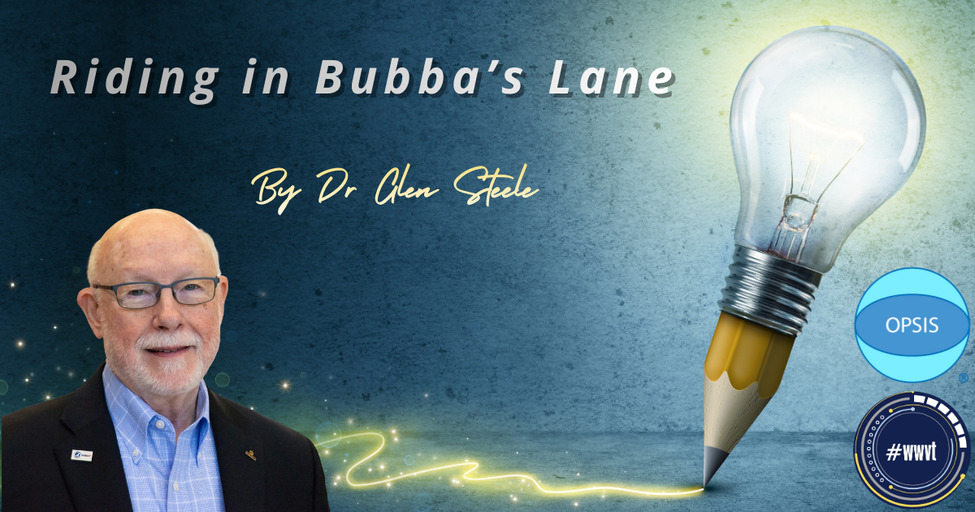Bubba’s Lane - BLOG Intro
Thoughts and Ideas from Glen T. (Bubba) Steele, OD FOVDRA-FAAO
Introduction
I started thinking about this type of communication during the pandemic. I would go into my office periodically and write down thoughts and ideas that came to mind. The more I did this, ideas came forth from many places and I began doing this every day. It may have been a sentence, a paragraph, or even a page, but I was motivated to move my ideas to the written word. I have spent many years developing an understanding of what vision is for, what vision development means, and the critical importance of vision in all aspects of development. My mentors were John Streff and Dick Apell and through them, I was exposed to the landmark works of Arnold Gesell, MD. I would be remiss to not include others who had indirect influence on my thinking and understanding these broader concepts of HOW an individual uses vision throughout life such as Jerry Getman, Bob Kraskin, Paul Harris, Greg Kitchener, and Steve Gallop. But the basis for my understanding of the importance of vision in all of development always goes back to Arnold Gesell.
I was fortunate to be able to spend a Fellowship year at the Gesell Institute of Child Development with Streff and Apell along with Al Fors, an SCO classmate. Al and I were the sixth and seventh to participate in the Gesell Fellowship. The reason for having the luxury of two fellows was that the Southern College of Optometry added a fellowship for the one year that we were there. The desk assigned to me was used by Gesell who had “retired” some ten years earlier.
Although Gesell had passed away, I was fortunate to work with Frances Ilg, MD, Louise Bates Ames, PhD, Richard Walker, PhD, and two wonderful people who provided educational assessments and guidance, Clyde Gillespie and Jackie Haines. In addition to daily eye and vision services which included vision therapy, members of this group would come together on Mondays and Fridays for a full day of testing on a single child - vision, psychological, and educational - and develop a plan for care for the child presented for evaluation and management. This early in my career, it seemed odd that the psychologists and educational specialists would ALWAYS first go to vision as the initial step in redirection and resolution of problems presented.
Through continued study and experience and seeing changes in the lives of children when vision is redirected, I came to more deeply understand the importance, the significance, and influence of Gesell’s work as it relates to vision. I also understand why he placed such importance on vision in the overall processes of development which was carried on by those who followed him. As I evolved from doing “eye exams” to changing lives of my patients, I now began to understand why these well-known psychologists and educators deferred to vision as the first step in care for children experiencing difficulty.
The bottom line is that I LEARNED TO TRUST THE PROCESS OF DEVELOPMENT and that vision is the explorer, the initiator, and instigator of action toward engagement, and it is involved in all aspects of development. Because vision is so intimately involved in development, we can use our observations of HOW the child visually Enters, Engages, and Exits a task to understand HOW the child might Enter, Engage, and Exit other tasks and activities throughout development. This comes from a direct quote from Gesell in Vision Its Development in Infant and Child (p 14); “No one of the major fields of behavior – motor, adaptive, language and personal-social – is normally devoid of visual content and controls. So interfused are vision and the action system that the two must be regarded as inseparable. To understand vision, we must know the child; to understand the child, we must know the nature of his vision.”
In this series, I hope to share other powerful concepts and quotes from Gesell and how they have shaped my growth and development through the years. I hope you will enjoy it. But my true hope is that you will be challenged to more deeply understand and observe HOW the patterns of visual behavior guide and direct all actions toward engagement.
Bubba
All rights reserved - Glen T. Steele and OPSIS Education Foundation 2025


